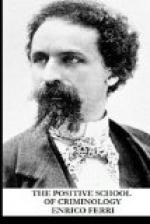In this method, this essential principle of the positive school of criminology, you will find another reason for the seemingly slow advance of this school. That is very natural. If you consider the great reform carried by the ideas of Cesare Beccaria into the criminal justice of the Middle Age, you will see that the great classic school represents but a small step forward, because it leaves the penal justice on the same theoretical and practical basis which it had in the Middle Age and in classic antiquity, that is to say, based on the idea of a moral responsibility of the individual. For Beccaria, for Carrara, for their predecessors, this idea is no more nor less than that mentioned in books 47 and 48 of the Digest: “The criminal is liable to punishment to the extent that he is morally guilty of the crime he has committed.” The entire classic school is, therefore, nothing but a series of reforms. Capital punishment has been abolished in some countries, likewise torture, confiscation, corporal punishment. But nevertheless the immense scientific movement of the classic school has remained a mere reform.
It has continued in the 19th century to look upon crime in the same way that the Middle Age did: “Whoever commits murder or theft, is alone the absolute arbiter to decide whether he wants to commit the crime or not.” This remains the foundation of the classic school of criminology. This explains why it could travel on its way more rapidly than the positive school of criminology. And yet, it took half a century from the time of Beccaria, before the penal codes showed signs of the reformatory influence of the classic school of criminology. So that it has also taken quite a long time to establish it so well that it became accepted by general consent, as it is today. The positive school of criminology was born in 1878, and although it does not stand for a mere reform of the methods of criminal justice, but for a complete and fundamental transformation of criminal justice itself, it has already gone quite a distance and made considerable conquests which begin to show in our country. It is a fact that the penal code now in force in this country represents a compromise, so far as the theory of personal responsibility is concerned, between the old theory of free will and the conclusions of the positive school which denies this free will.
You can find an illustration of this in the eloquent contortions of phantastic logic in the essays on the criminal code written by a great advocate of the classic school of criminology, Mario Pagano, this admirable type of a scientist and patriot, who does not lock himself up in the quiet egoism of his study, but feels the ideal of his time stirring within him and gives up his life to it. He has written three lines of a simple nudity that reveals much, in which he says: “A man is responsible for the crimes which he commits; if, in committing a crime, his will is half free, he is responsible to the extent of one-half;




